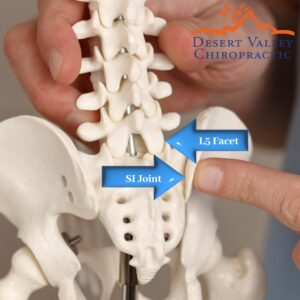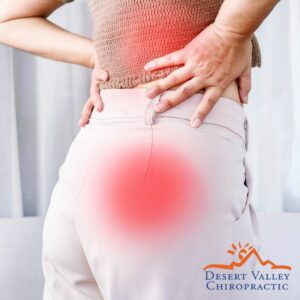So … You have a pain in the Butt?
In our office we see this all the time, patients will tell us it hurts right here! Then they point to the top of the glute area or sacroiliac joint (SI joint). It is a particularly common problem with people who sit a lot for work, even with an ergonomically correct set up. While there certainly can be multiple reasons to have pain to have a “pain in the butt” we typically will see problems with the fifth lumbar vertebrae (L5) and or an SI joint that has locked up.
The Anatomy of the problem:
The sacroiliac (SI) joint and the lumbar spine are intricately connected. They play vital roles in maintaining the stability and flexibility of the lower back and pelvis. The lumbar spine, composed of the five vertebrae in the lower back, supports much of the upper body’s weight and enables a range of movements, including bending and twisting. At the base of the lumbar spine lies the sacrum, a triangular bone that fits between the two ilium bones of the pelvis. This forms the sacroiliac joint or SI joints on either side.
These joints act as shock absorbers, distributing the forces exerted on the spine and pelvis during activities like walking, lifting, and running. The connection between the lumbar spine and the SI joints ensures a seamless transfer of weight and motion from the upper body to the lower limbs. This facilitates smooth and coordinated movements. However, any dysfunction in the SI joints can disrupt this balance, leading to pain and limited mobility. Understanding this connection is crucial for diagnosing and treating lower back and pelvic pain effectively.

Common Causes of the pain in your Butt (no its not your spouse):
Experts have difficulty estimating the number of people that suffer with SI joint pain because of the prevalence of low back complaints. Still, it is estimated that a third of the patient with low back pain also have pain related to joint dysfunction of the SI joint. This equates to roughly 204 million people world wide who have pain in and around the SI joints. There can be many factors that result in you having a pain in the butt including:
- Repetitive Stress: Activities that involve repetitive motion, like running or heavy lifting, can strain the SI joint.
- Too much sitting: Many people sit for long periods of time while at work, and this can put pressure into the SI joint and low back, as well as causing the muscles in the area to tighten up.
- Prolonged standing: Standing for a long period of time, and sometimes standing on a hard surface can be hard on the SI joints, causing them to get inflamed and irritated.
- Injury or Trauma: A sudden impact, such as a fall or car accident, can injure the SI joint.
- Pregnancy: Hormonal changes and increased weight during pregnancy can put extra stress on the SI joint.
- Arthritis: Degenerative arthritis or ankylosing spondylitis can affect the SI joint.
- Poor Posture: Prolonged sitting or standing with poor posture can contribute to SI joint dysfunction.
Symptoms of SI Joint Pain:
The symptoms of SI joint pain can vary but often involve pain in the low back, pelvic pain, limited range of motion and worsening pain with movement. Some common examples include:
- Pain rolling over in bed
- Increase pain while standing
- Increase in pain while sitting
- Increase in pain while climbing stairs
- Increase in pain while walking or running
- increase in pain with large steps forward
Treatment Options for SI Joint Pain:
The treatments for SI joint pain may vary, but at Desert Valley Chiropractic we focus fixing the joint dysfunction so you can move and be pain free. We offer various treatment options for managing SI joint pain:
- Chiropractic Adjustments: Using the Activator Methods technique, we can check and isolate if the problem is cause by joint dysfunction of the sacroiliac joint and or the lumbar spine. Then we provide precise adjustments to restore joint function and alleviate pain.
- Physical Therapy: Tailored exercises and stretches can strengthen the muscles around the SI joint and improve flexibility.
- Lifestyle Modifications: Recommendations for ergonomic changes, posture correction, and activity modification can help reduce strain on the SI joint.
- Pain Management: Techniques like ice/heat therapy, massage, and over-the-counter pain relievers can provide symptomatic relief.
- Referral to Specialists: In severe cases, we may refer patients to orthopedic specialists for further evaluation and treatment.
Why Choose Desert Valley Chiropractic?
At Desert Valley Chiropractic, Dr, Dave and Dr Katherine who were recently feature as Top Chiropractor in Phoenix specializes in gentle, effective treatments that address the root cause of your pain. We are committed to helping you feel better, move better, and live better. I
If we can help with your SI joint pain please schedule and appointment here or call us at 602-439-1515. Let’s work together to get you back to a pain-free life!





